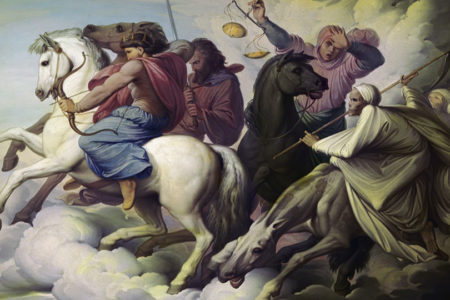Perusing the Future Matthew 24:1–14
Futurists have been divided over whether or not the Olivet Discourse has already been partially fulfilled. The argument hinges on whether Matthew 24:4–14 describes general characteristics of the Church Age1 or only the future, seven-year Tribulation.
These verses speak of “wars and rumors of wars” (v. 6); “famines, pestilences, and earthquakes” (v. 7); tribulation, martyrdom, betrayal, hatred, false prophets, and lawlessness (vv. 9–12).
Despite what some people teach today, verses 4–14 must be eschatological and refer to the events of the first half of the Tribulation for several reasons.
The Conditions
The conditions described must be considered divine judgments rather than “natural” disasters, in keeping with the pattern of Old Testament revelation. Jesus said, “All these are the beginning of sorrows [literally, “birth pains”]“ (v. 8). In the Old Testament the prophets used a Hebrew word for “birth pains” to symbolize the terrible calamities that accompany the Day of the Lord (Isa. 21:3; 26:17–18; 66:7; Jer. 4:31; Mic. 4:10), particularly “the time of Jacob’s trouble” (Jer. 30:6–7) alluded to in the description of the Great Tribulation in Matthew 24:21.2
Many Jewish people during the second Temple period believed a time of suffering would immediately precede the end. (See 4 Ezra 9:3; 13:31–32; 2 Baruch 27:7; 70:3; Sibylline Oracles 2:22–24; 3:660–61.) The Jewish sect at Qumran referred to these troubles as “birth pangs.” (See Qumran Hymns.)
Rabbinic Judaism likewise spoke of the “birth pangs [Hebrew, chavalim] of the Messiah” as a series of worldwide convulsions that would precede the Messianic Age. The Talmud’s list of these disastrous spiritual, moral, political, social, and environmental conditions that will characterize “the generation when the Son of David is to come” (Sanhedrin 97a) closely parallels the list in Matthew 24:4–14.3
Since the New Testament indicates the church will not experience the judgments of God that have been appointed for the Day of the Lord (1 Th. 5:9; Rev. 3:10), these verses cannot describe events within the Church Age.
The Sequence
Second, Jesus stated that these judgments are not “the end” of the judgments but merely the “beginning” (v. 8). After beginning birth pains the more intense birth pains come that cli-max the birth process. Since the Tribulation does not immediately begin after the Rapture of the church, but begins with the commencement of Daniel’s 70th week (Dan. 9:27), these verses cannot describe events within the Church Age.
The most compelling argument for a Tribulation context for these verses comes from a comparison of verses 4–14 with the first five seal judgments in Revelation 6.
CORRELATION CHART 1
| Condition | Gospels | Revelation 6 |
|---|---|---|
| False messiahs/Prophets | Mt. 24:5, 11 | v. 2 |
| Wars | Mt. 24:6–7 | vv. 2–4 |
| International Discord | Mt. 24:7 | vv. 3–4 |
| Famines | Mt. 24:7 | vv. 5–8 |
| Pestilence | Lk. 21:11 | v. 8 |
| Persecution/martyrdom | Mt. 24:9 | vv. 9–11 |
| Earthquakes | Mt. 24:7 | v. 12 |
| Cosmic Phenomena | Lk. 21:11 | vv. 12–14 |
These parallel conditions demonstrate that, just as the seal judgments of Revelation 6 lead to the more intense trumpet and bowl judgments of the Great Tribulation, so, too, the “beginning” birth-pain conditions described in Matthew 24:4–14 lead to the more intense, final “birth pains” described in Matthew 24:15–26, which result in the climatic advent of the Messiah (vv. 27–31).
Furthermore, Jesus himself referred to Daniel’s prophecy of the 70th week:
“Therefore when you see the ‘abomination of desolation,’ spoken of by Daniel the prophet [Dan. 9:27], standing in the holy place” (whoever reads, let him understand), “then let those who are in Judea flee to the mountains” (24:15–16).
Both Matthew and Mark (Mk. 13:14) tell the reader to consider this text as a means to understanding the prophecy of the Olivet Discourse. In other words, Jesus used the 70th-week prophecy as the template for the chronological events He unfolded in His response to the disciples’ questions. This also applies to the judgment section of Revelation (chapters 4—19) where Jesus, the one who gave the Revelation vision to the apostle John (Rev. 1:1), modeled the vision on the structural divisions of Daniel’s 70th week.
Viewing these texts together, we find that the “beginning” birth pains of Matthew 24:4–14 correlate with the seal judgments of Revelation 4—6, which (1) have a terrestrial focus; (2) fit within the first half of Daniel’s 70th week (Dan. 9:27a); and (3) climax with the pivotal event of the Temple’s desecration (abomination of desolation) in Matthew 24:15 and Mark 13:14, the midpoint of Daniel’s 70th week (Dan. 9:27b).
CORRELATION CHART 2
| First Half of the Week | |
|---|---|
| Dan. 9:27a | Beginning Birth Pains (terrestrial focus) |
| Rev. 4—6 | Seal Judgments |
| Mt. 24:4–14; Mk. 13:4–13; Lk. 21:8–19 | Preliminary Signs |
| Second Half of the Week | |
|---|---|
| Dan. 9:27b | Pivotal Events |
| Rev. 7—13 | Trumpet Judgments |
| Mt. 24:15; Mk. 13:14–23; Lk. 21:20–24 | Abomination of Desolation |
| Conclusion of the Week | |
|---|---|
| Dan. 9:27b | Final Birth Pains (celestial focus) |
| Rev. 14—19 | Bowl Judgments |
| Mt. 24:29–31; Mk. 13:24–27; Lk. 21:25–28 | The Parousia (“bodily presence”) and Close of End-Times |
Events then intensify to concluding birth pains in Matthew 24:16–26, which (1) correlate with Revelation 7—19, (2) have a celestial focus, and (3) climax with the heavenly appearing of “the sign” of Messiah’s advent to Earth in judgment (Mt. 24:27–31; Rev. 19). These events fit within the last half of Daniel’s 70th week (Dan. 9:27b), which concludes with the destruction of the Temple’s desolator (“the prince who is to come,” the Antichrist, Dan. 9:26).
If verses 4–14 predict signs that are for the future Tribulation and relate primarily to the Jewish people of that day, they cannot have had a past fulfillment, especially not with the fall of Jerusalem in A.D. 70. Comparing the events in these verses reveals that they cannot be identified with first-century historical events.
The passage describes wars between many different nations and kingdoms, not between a single nation (Rome) and Israel, as occurred in the Jewish people’s First Revolt against Rome (A.D. 66–74).
Likewise, Scripture says there will arise many claiming to be Christ (messiah). But no historical evidence exists of anyone claiming to be a messiah in the first century until Simon Bar-Kokhba (A.D. 135), and then it was only a single individual making this claim.4
Neither can the signs be used by the church as “signs of the times” to indicate the nearness of the Lord’s coming. many Christians have used the apparent increasing frequency of earthquakes, apostasy in the church, and moral decline in society in general as indicators that we are fast approaching the Rapture and the end-times. However, the Rapture is a signless event; and since these birth pains do not begin until Israel enters “the time of Jacob’s trouble” (and we do not know how long this will be after the Rapture), we must exercise caution in trying to predict the nearness of end-times events based on the presence of these conditions in the present age.
During the Church Age these general conditions (given in 1 Tim. 4:1–3; 2 Tim. 3:1–9; 1 Jn. 2:18; 4:1–3) remind us we are in the “last days.” But during the Tribulation, the conditions of verses 4–14 become specific signs of the end-times, whereby “you” (in context, this word means the disciples’ people, or Jewish believers) will be able to discern where they are in the 70th week and endure to the end of the Tribulation: “But he who endures to the end shall be saved,” meaning physically delivered at the messiah’s advent (v. 13).
These signs—and especially the signal event of verse 15, the abomination of desolation—will enable Tribulation saints to persevere physically and spiritually as they await their promised rescue at the end of Daniel’s 70th week.
ENDNOTES
- See John F. Walvoord, Matthew: Thy Kingdom Come (Chicago: Moody Press, 1974), 182–84.
- For additional study see Randall Price, “Old Testament Tribulation Terms,” in When the Trumpet Sounds, ed. Thomas Ice and Timothy J. Denny (Eugene, OR: Harvest House, 1995), 71–72.
- See David H. Stern, Jewish New Testament Commentary (Clarksville, MD: Jewish New Testament Publications, Inc., 1996), 72–73.
- Thomas Ice, “The Olivet Discourse,” in The End Times Controversy, ed. Tim LaHaye and Thomas Ice (Eugene, OR: Harvest House, 2003), 167–170.







1 thought on “Perusing the Future Matthew 24:1–14”